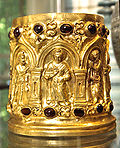Portal:Afghanistan
The Afghanistan Portal
Afghanistan, officially the Islamic Emirate of Afghanistan, is a landlocked country located at the crossroads of Central Asia and South Asia. It is bordered by Pakistan to the east and south, Iran to the west, Turkmenistan to the northwest, Uzbekistan to the north, Tajikistan to the northeast, and China to the northeast and east. Occupying 652,864 square kilometers (252,072 sq mi) of land, the country is predominantly mountainous with plains in the north and the southwest, which are separated by the Hindu Kush mountain range. Kabul is the country's capital and largest city. Afghanistan's population is estimated to be between 36 and 50 million. Human habitation in Afghanistan dates to the Middle Paleolithic era. Popularly referred to as the graveyard of empires, the land has witnessed numerous military campaigns, including those by the Persians, Alexander the Great, the Maurya Empire, Arab Muslims, the Mongols, the British, the Soviet Union, and a US-led coalition. Afghanistan also served as the source from which the Greco-Bactrians and the Mughals, among others, rose to form major empires. Because of the various conquests and periods in both the Iranian and Indian cultural spheres, the area was a center for Zoroastrianism, Buddhism, Hinduism, and later Islam. The modern state of Afghanistan began with the Durrani Afghan Empire in the 18th century, although Dost Mohammad Khan is sometimes considered to be the founder of the first modern Afghan state. Afghanistan became a buffer state in the Great Game between the British Empire and the Russian Empire. From India, the British attempted to subjugate Afghanistan but were repelled in the First Anglo-Afghan War; the Second Anglo-Afghan War saw a British victory. Following the Third Anglo-Afghan War in 1919, Afghanistan became free of foreign political hegemony, and emerged as the independent Kingdom of Afghanistan in 1926. This monarchy lasted almost half a century, until Zahir Shah was overthrown in 1973, following which the Republic of Afghanistan was established. Afghanistan is rich in natural resources, including lithium, iron, zinc, and copper. It is the second-largest producer of cannabis resin, and third largest of both saffron and cashmere. The country is a member of the South Asian Association for Regional Cooperation and a founding member of the Organization of Islamic Cooperation. Due to the effects of war in recent decades, the country has dealt with high levels of terrorism, poverty, and child malnutrition. Afghanistan remains among the world's least developed countries, ranking 182nd on the Human Development Index. Afghanistan's gross domestic product (GDP) is $81 billion by purchasing power parity and $20.1 billion by nominal values. Per capita, its GDP is among the lowest of any country as of 2020[update]. (Full article...) Selected article - A T20I is an international cricket match between two teams that have official Twenty20 International status, as determined by the International Cricket Council. It is played under the rules of Twenty20 cricket and is the shortest form of the game. Afghanistan played its first T20I match on 1 February 2010, against Ireland, losing the match by 5 wickets. Their first win came three days later in their second T20I match, which was against Canada, with Afghanistan winning by 5 wickets with one ball remaining. This list comprises all members of the Afghanistan cricket team who have played at least one T20I match. It is initially arranged in the order in which each player won his first Twenty20 cap. Where more than one player won his first Twenty20 cap in the same match, their surnames are listed alphabetically. (Full article...) Did you know? -
General images -The following are images from various Afghanistan-related articles on Wikipedia.
Related portalsReligions in Afghanistan Neighboring countries Other countries Selected picture - A view of Herat Citadel from atop the premises
TopicsRecognized content
Featured articlesGood articles
Featured pictures
CategoriesNew articlesThis list was generated from these rules. Questions and feedback are always welcome! The search is being run daily with the most recent ~14 days of results. Note: Some articles may not be relevant to this project.
Rules | Match log | Results page (for watching) | Last updated: 2025-06-22 19:31 (UTC) Note: The list display can now be customized by each user. See List display personalization for details.
WikiProjects
Associated WikimediaThe following Wikimedia Foundation sister projects provide more on this subject:
External mediaSourcesDiscover Wikipedia using portals | ||||||























































































